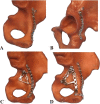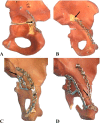Are quadrilateral surface buttress plates comparable to traditional forms of transverse acetabular fracture fixation?
- PMID: 25080262
- PMCID: PMC4182403
- DOI: 10.1007/s11999-014-3800-x
Are quadrilateral surface buttress plates comparable to traditional forms of transverse acetabular fracture fixation?
Erratum in
- Clin Orthop Relat Res. 2015 Jan;473(1):402
Abstract
Background: Several construct options exist for transverse acetabular fracture fixation. Accepted techniques use a combination of column plates and lag screws. Quadrilateral surface buttress plates have been introduced as potential fixation options, but as a result of their novelty, biomechanical data regarding their stabilizing effects are nonexistent. Therefore, we aimed to determine if this fixation method confers similar stability to traditional forms of fixation.
Questions/purposes: We biomechanically compared two acetabular fixation plates with quadrilateral surface buttressing with traditional forms of fixation using lag screws and column plates.
Methods: Thirty-five synthetic hemipelves with a transverse transtectal acetabular fracture were allocated to one of five groups: anterior column plate+posterior column lag screw, posterior column plate+anterior column lag screw, anterior and posterior column lag screws only, infrapectineal plate+anterior column plate, and suprapectineal plate alone. Specimens were loaded for 1500 cycles up to 2.5x body weight and stiffness was calculated. Thereafter, constructs were destructively loaded and failure loads were recorded.
Results: After 1500 cycles, final stiffness was not different with the numbers available between the infrapectineal (568±43 N/mm) and suprapectineal groups (602±87 N/mm, p=0.988). Both quadrilateral plates were significantly stiffer than the posterior column buttress plate with supplemental lag screw fixation group (311±99 N/mm, p<0.006). No difference in stiffness was identified with the numbers available between the quadrilateral surface plating groups and the lag screw group (423±219 N/mm, p>0.223). The infrapectineal group failed at the highest loads (5.4±0.6 kN) and this was significant relative to the suprapectineal (4.4±0.3 kN; p=0.023), lag screw (2.9±0.8 kN; p<0.001), and anterior buttress plate with posterior column lag screw (4.0±0.6 kN; p=0.001) groups.
Conclusions: Quadrilateral surface buttress plates spanning the posterior and anterior columns are biomechanically comparable and, in some cases, superior to traditional forms of fixation in this synthetic hemipelvis model.
Clinical relevance: Quadrilateral surface buttress plates may present a viable alternative for the treatment of transtectal transverse acetabular fractures. Clinical studies are required to fully define the use of this new form of fixation for such fractures when accessed through the anterior intrapelvic approach.
Figures





References
Publication types
MeSH terms
LinkOut - more resources
Full Text Sources
Other Literature Sources
Medical

